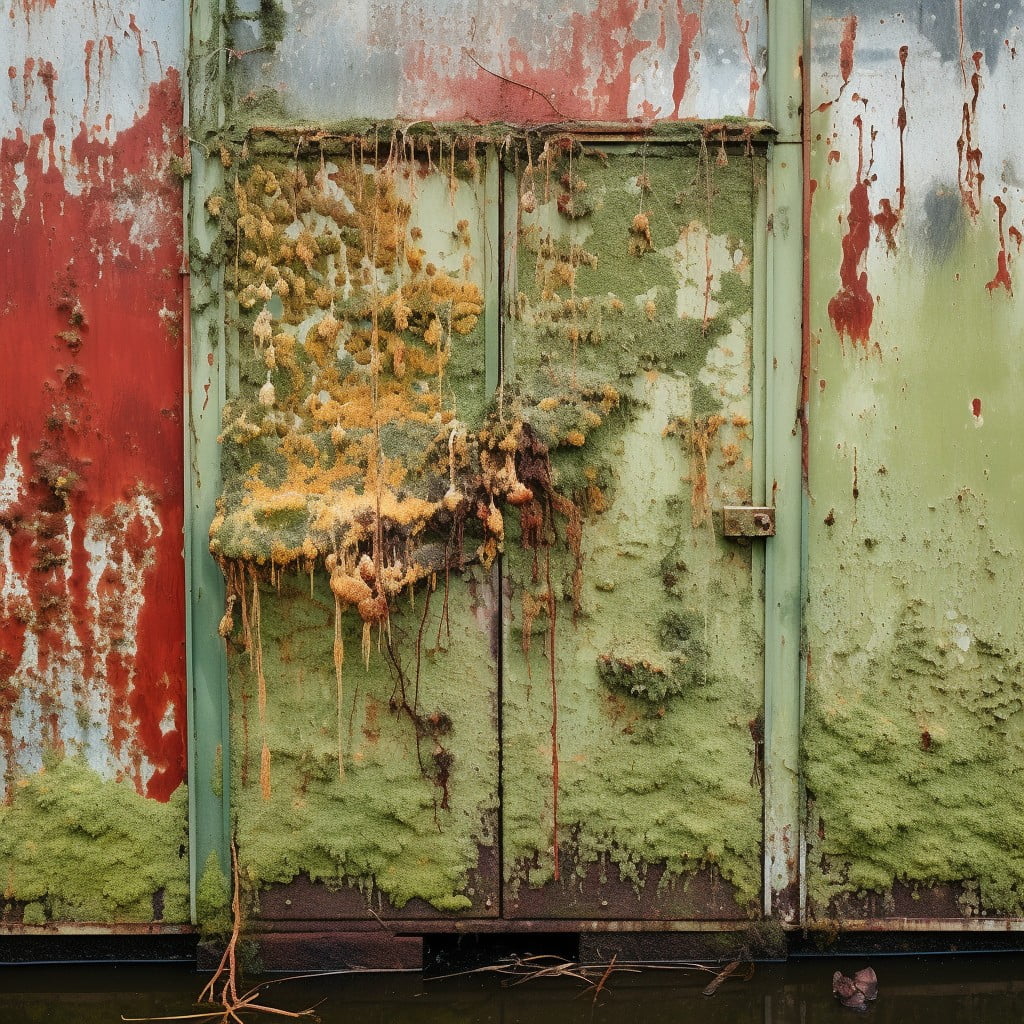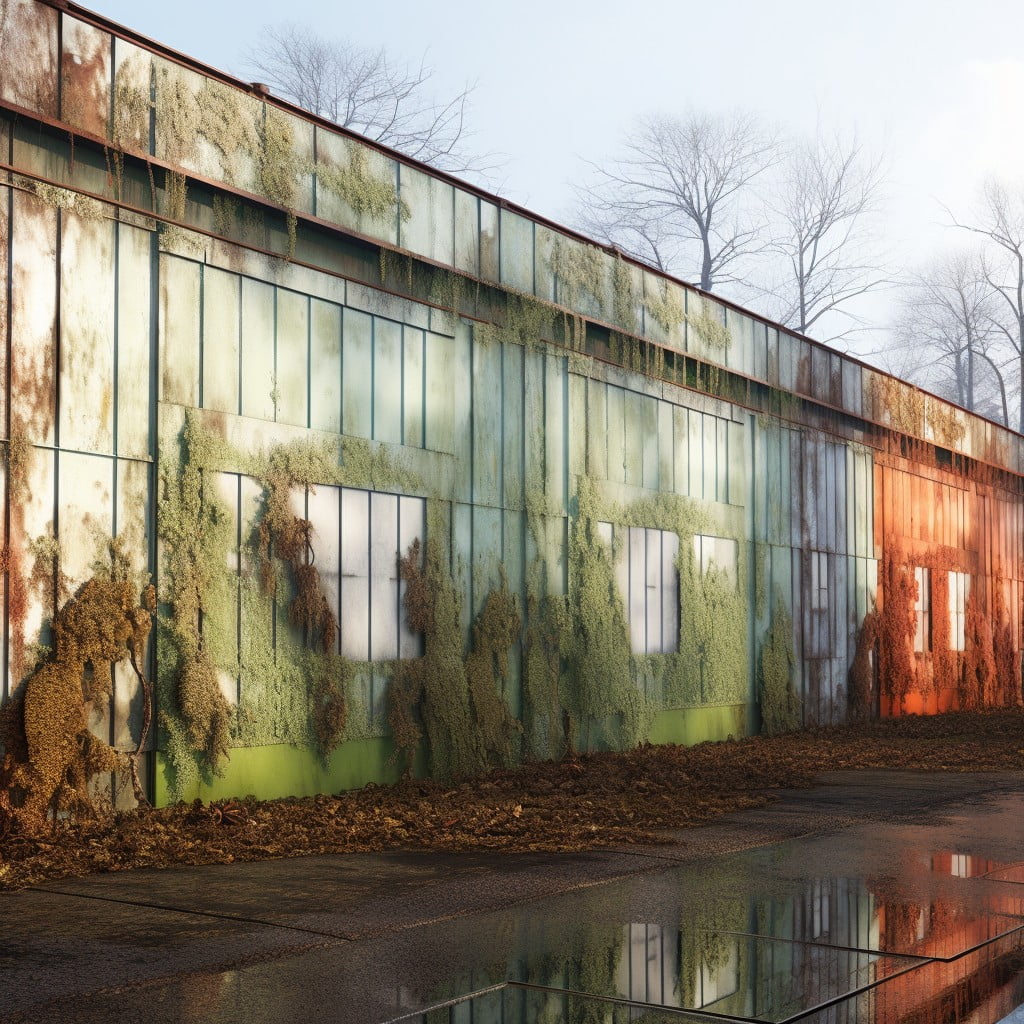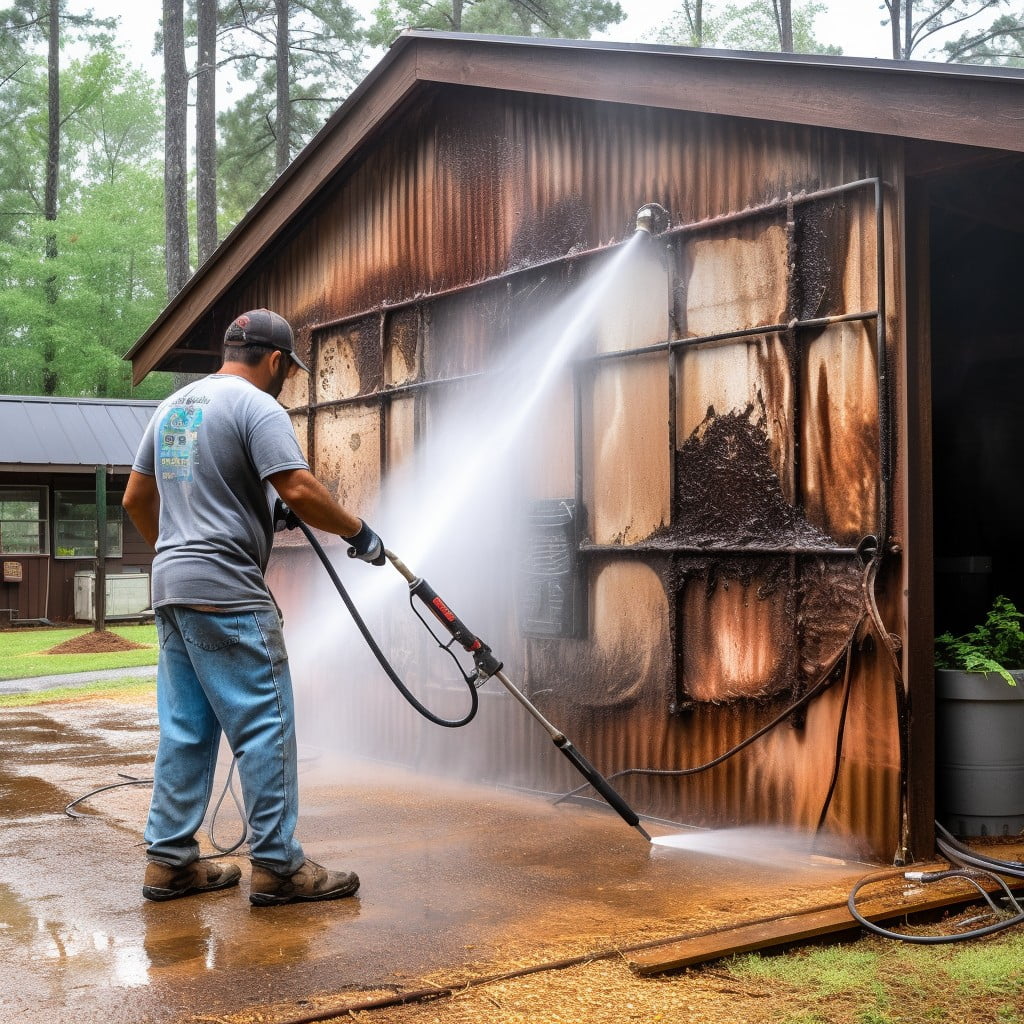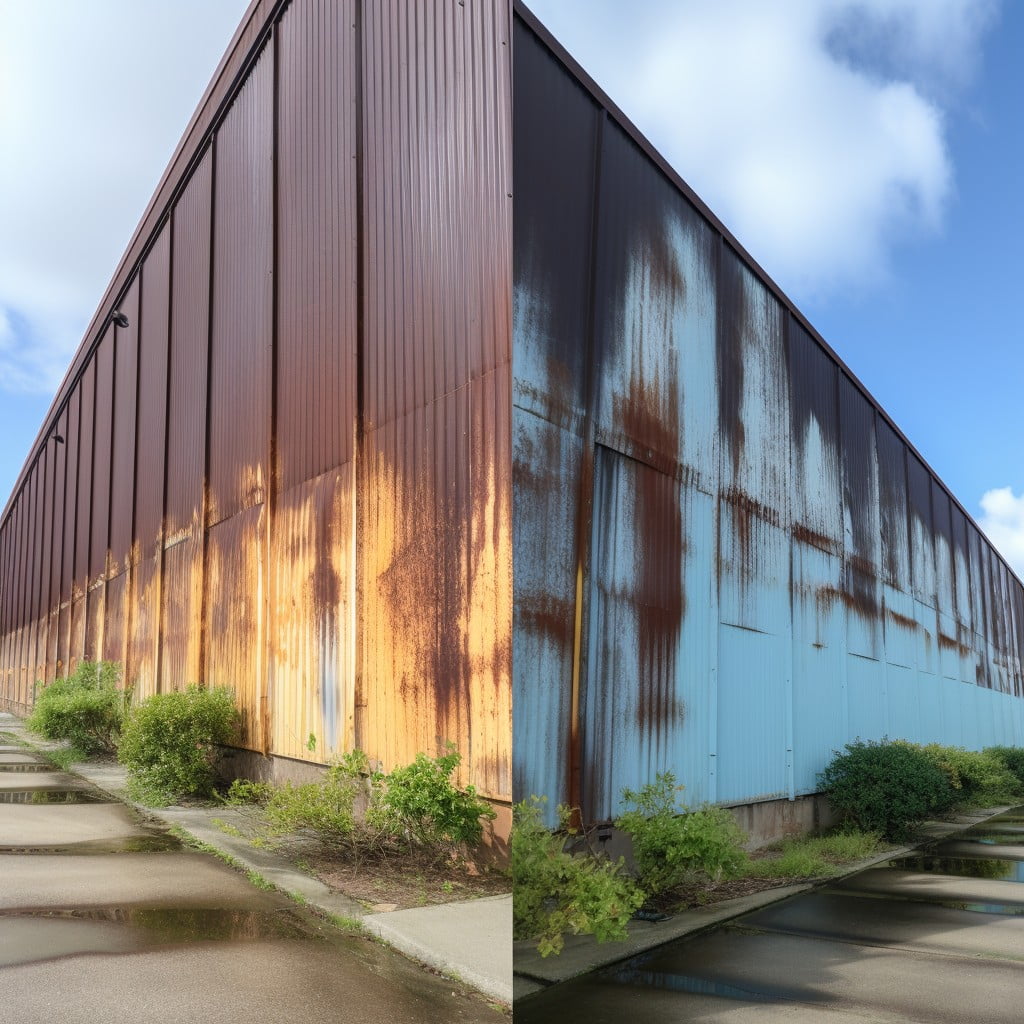Discover effective methods for removing mildew from metal buildings, ensuring a clean and healthy environment.
Mildew can be a pesky problem for metal buildings, but fear not, it is definitely manageable. This article will guide you through the step-by-step process of effectively removing mildew from your metal structure. From identifying the problem areas to choosing the right cleaning solution, all the way to preventative measures to keep the mildew from returning, we’ve got you covered.
So, if you’re keen on maintaining the longevity and aesthetics of your metal building, this comprehensive guide is your go-to resource.
Key takeaways:
- Differentiate between mildew, algae, and mold on metal buildings.
- Understand how location affects mildew growth on metal buildings.
- Use a power washer and the correct pressure to clean mildew.
- Address rust stains when cleaning mildew from metal buildings.
- Take preventive measures to avoid mildew growth on metal buildings.
Understanding Mildew, Algae, and Mold On Metal Buildings

Firstly, we need to differentiate between the three common culprits threatening the upkeep of metal buildings: mildew, algae, and mold. Mildew often appears as a thin dusting of grey or white powder. It thrives in damp conditions and is typically found on the surface of materials, making it relatively easy to clean.
On the other hand, algae, manifesting as a green layer, usually grows where sunlight is readily available and where water tends to pool. It’s important to note that while algae might cosmetically affect your building, they won’t cause structural damage.
Lastly, mold, which can appear in many colors, has a fuzzy or slick texture. It is a more serious concern, as it not only impacts the aesthetics of your building but can also lead to severe structural damage if left untreated, as it eats away at the surfaces it inhabits.
Hence, it’s crucial to accurately identify whether you’re dealing with mildew, algae, or mold, as the cleaning methods and preventive measures can vary for each.
How Location Matters in Mildew Growth On Metal Buildings

Various geographic conditions significantly influence the buildup of mildew on metal structures. In hot, humid climates, these buildings tend to retain moisture, providing a conducive environment for mildew growth. Proximity to bodies of water or areas that experience heavy rainfall or condensation can exacerbate this situation.
Sun exposure can also play a role. Buildings frequently in the shade often remain damp longer and invite persistent mildew issues. Meanwhile, structures in direct sunlight dry quickly, reducing the mildew’s chance of survival.
The direction your building is facing matters as well. North-facing walls, for instance, often get less sun and more dampness, creating a perfect environment for mildew. Today’s metal building planners consider these factors during site selection to minimze potential for excessive exposure to such elements, helping reduce future mildew-related problems.
Thus, understanding your locale’s specifics assists in effectively managing and preventing mildew formation on your metal buildings.
The Role of Power Washer in Cleaning Mildew Off Metal Buildings

A power washer can be your ally in the battle against mildew. When used correctly, it can efficiently remove the unsightly growth without causing damage to the metal surface.
Firstly, it’s crucial to choose the right pressure. Excessive force can cause dents or scratches, while insufficient pressure might not eliminate the mildew effectively. For most metal buildings, a medium setting will work just fine.
Secondly, it’s advantageous to combine the use of a power washer with a mildew-specific cleaning agent. The solution, sprayed through the washer, helps in weakening the mildew, making it easier to wash away.
Lastly, keep an even and controlled movement. Sweeping the hose in a steady side-to-side motion will help ensure that all areas are evenly cleaned. Avoid holding the spray in one area for too long, as it might damage the paint or metal underneath.
A power washer can significantly hasten the cleaning process, but remember: proper technique and cautious execution are paramount.
Addressing Rust Stains When Cleaning Mildew From Metal Buildings

When dealing with mildew on your metal building, one might also encounter rust stains. This typically stems from the oxidation of the underlying metal, often provoked by the constant moisture provided by the mildew itself. Dealing with these rust stains effectively is as vital as dealing with the mildew to maintain the integrity and aesthetic appeal of the building.
1. Detecting Rust: The first step would be identifying the rust stains. These are recognizable by their distinct reddish-brown color that contrasts significantly with the original color of the metal surface.
2. Rust Removal Solutions: Using rust removal solutions proves an effective way to tackle these stains. Various commercial rust removers are available in the market, which contain distinct chemicals designed to react with the rust and remove it.
3. Careful Application: Apply the rust remover directly to the stained areas, following the safety guidelines provided on the product. Most of these solutions are potent enough to also remove any remaining mildew.
4. Alternative Methods: For a more eco-friendly approach, consider natural rust removal options such as a mixture of baking soda and lemon juice, which needs to be applied and then scrubbed off.
Remember, protective gear is necessary during this process to avoid skin or eye irritation from the chemicals involved.
Essential Tips On How to Clean Mildew From a Metal Building
Start off with a basic washing using warm, soapy water and a long-handled brush. This step helps to dislodge the surface growth of the mildew. For those areas with heavier growth, use a mix of vinegar and water, usually at a 1:3 ratio. Note that vinegar is a natural disinfectant which can kill up to 82% of mildew species.
Next, consider using a bleach solution for stubborn stains. Combine one part bleach with ten parts water and a generous amount of detergent. Always remember to rinse the area thoroughly after bleach application to avoid possible staining or corrosion.
While cleaning, pay special attention to seams, rivets, and other hard-to-reach areas where mildew tends to cling. You may require smaller hand brushes to reach these points effectively.
Lastly, always wear protective clothing and eyewear when using bleach or other potent cleaning products. Safety should never be overlooked in your cleaning efforts.
Preventive Measures to Avoid Mildew Growth On Metal Buildings
Regular inspection is paramount for early detection and rectification. Be observant for any signs of mold or mildew during your inspection, particularly in corners and less ventilated areas.
Opt for good ventilation, even in less obvious spaces. Mildew thrives in damp and poorly illuminated environments, so increasing air circulation and light exposure can deter growth.
Use of sealants and preventive coatings on the metal surfaces can boost resistance against moisture, a key trigger for mildew.
Carry out immediate repair of leaks. Prolonged water exposure to the metal surfaces accentuates the problem, hence halting this moisture at the source quickly can thwart mildew formation.
Ensure adequate drainage around the building. Pooling water can elevate the humidity levels around your metal building, increasing the likelihood of mildew.
Lastly, regular professional cleanings might be a prudent investment. Professionals can deep-clean those parts of the metal building most susceptible to mildew and ward off infestation before it takes hold.
Importance of Regular Maintenance for Metal Buildings
Performing routine checks on your metal building can significantly reduce the risk of mildew build-up. Make it a habit to inspect your structure for any signs of moisture accumulation. This may form in hidden corners or areas where condensation often occurs.
Direct sunlight can naturally hinder mildew growth. Ensure that your structure, especially the roof, gets enough sunlight. Getting professional help for tree trimming might be beneficial in such a case.
Keeping your structure well-ventilated is vital. Any trapped humidity can foster mildew. Install adequate ventilation systems, such as extractor fans or vents, to expel any excess moisture.
Coating your building with a mildew-resistant finish can make a world of difference. Opt for premium-quality paints or finishes that repel moisture and inhibit the growth of mildew.
Cascade your maintenance efforts to the surroundings as well. Overhanging trees or nearby plants can contribute to a moist environment. Keep your surrounding vegetation neat and tidy to mitigate mildew growth.
Regular maintenance not only elongates the life of your metal building but also ensures it looks as good as new. A little effort can go a long way in keeping your structure mildew-free and aesthetically pleasing.
FAQ
How do you get mold off metal buildings?
To remove mold from metal buildings, mix 1/3 cup of powdered laundry detergent, 1 quart of bleach (5% solution), and 3 quarts of water, then use a soft brush or rag to apply this solution to the affected areas.
How do you get rid of mold in a metal shed?
To eradicate mold in a metal shed, deep clean the interior with a solution of one cup of bleach to a gallon of water, then spray all surfaces and scrub off any visible mold using a sponge.
What is the best cleaner for metal buildings?
The best cleaner for metal buildings is a mild, phosphate-free detergent mixed with water, ideally used for cleaning at least twice a year.
Can you use bleach to clean a metal building?
Yes, bleach can be used to clean a metal building, but care must be taken to dilute it properly and not to use too much to prevent damage to the finish.
What are the preventative measures to keep mildew from forming on metal buildings?
To prevent mildew formation on metal buildings, ensure proper ventilation, routinely clean and inspect the surfaces, and apply an anti-mildew coating.
Can vinegar be used as a natural solution for removing mold from a metal structure?
Yes, vinegar, due to its acidic nature, can be used as a natural solution for removing mold from metal structures.
What potential damage can mold and mildew cause if left unchecked on metal buildings?
Unchecked mold and mildew can cause extensive structural damage to metal buildings by accelerating the corrosion process.
Recap




